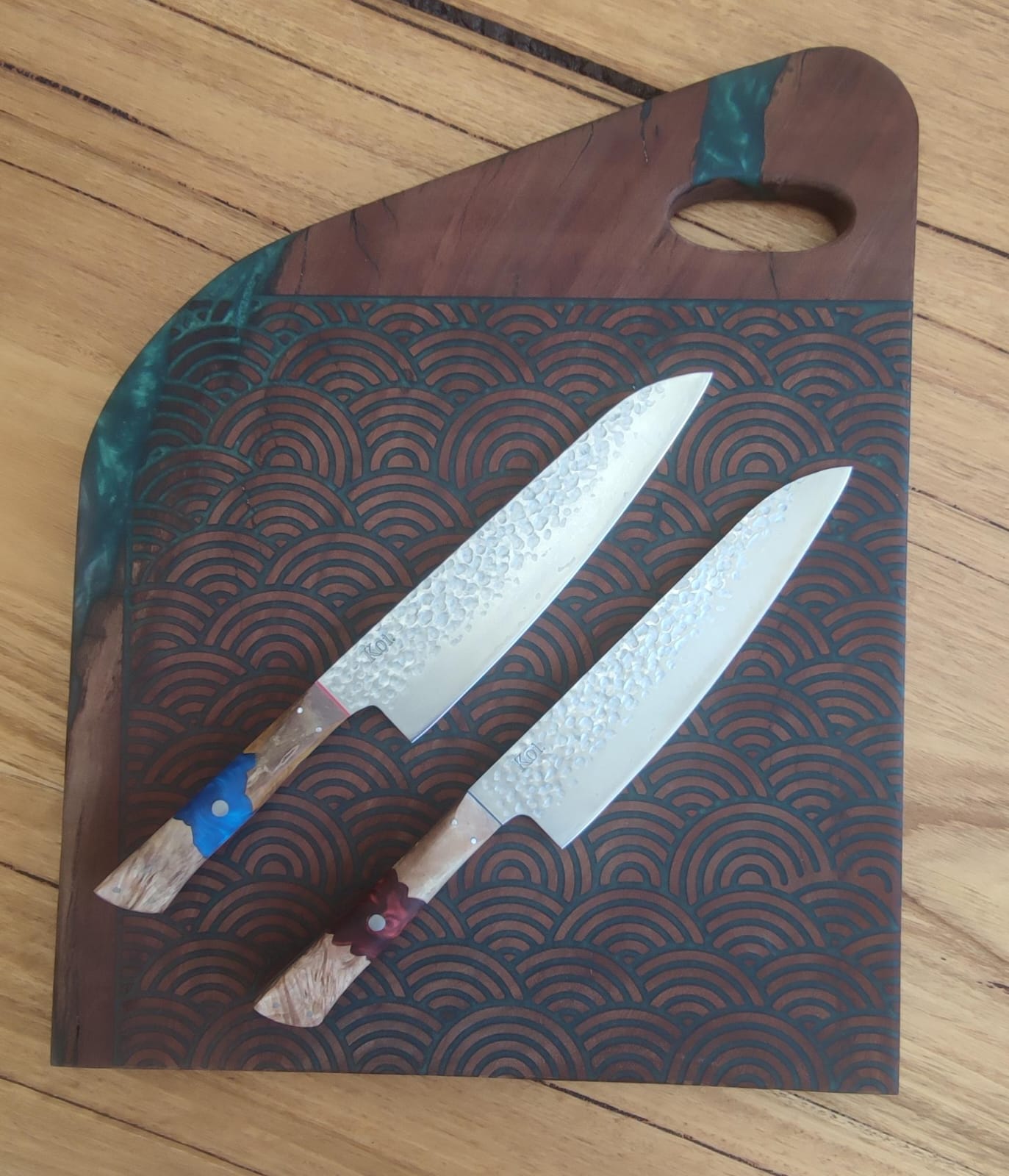While there are a lot of different knives out there, two lesser known styles are the Tanto and Reverse Tanto knives. When you’re preparing your food, nothing is more frustrating than using a knife that doesn’t work with you. In some cases, it’s because the knife’s blade has become dull but it could also mean that you’re using the wrong knife for your ingredients.
These two knives have a rich history, whether it's samurai origins or modern ingenuity. Before you get around to using either or both of these knives, you need to know their key differences to properly use them. After all, there’s more to choosing the right kitchen knife than just liking its design. Read below to fully understand the differences between Tanto and Reverse Tanto knives.
What is a Tanto knife?
Tanto knives are recognisable by their angled tip, a design that is taken directly from combat weapons. The sharpened angular tip is designed to puncture through armour, allowing the wielder to use both striking and slashing attacks. Effectively giving the knife two distinct edges, one through the length of the blade and another at its tip.

If you’re looking for a knife that has a long and rich history before it was used in the kitchen, then the Tanto knife is the one for you. Back in the Heian period between 794 AD up to 1185 AD in Japan, the Tanto knife was created out of necessity to have a shorter version of the samurai sword. In this case, it was often used for self defense and the last weapon that warriors of that time wielded since it was a compact and sharp blade.
Since the Tanto knife’s blade was often made between 6 to 12 inches, it can easily be hidden within a person’s clothes. Additionally, since it is a smaller version of a samurai sword, its features look the same. This means, the spine of the Tanto knife is straight and on the side where the sharp edge is, there is an acute angle at its point. Besides being created to resemble a sword, you can use it as you would a long sword, since it’s the perfect tool for slicing and stabbing through hard surfaces.
Within the kitchen, if you want to cut through food with hard exteriors like pineapples or pumpkins, then the Tanto tip knife is a great choice. Using the sharpened angular tip in a push cut, the tip glides through ingredients with ease. The reinforced spine of the blade makes sure the tip does not bend or fracture when cutting.
What is a Reverse Tanto knife?
Unlike the Tanto knife, the Reverse Tanto knife wasn’t created at the same time in Japan. This was only created back in the 80s by American knife company Cold Steel. They revolutionised the industry modernising the traditional Tanto knife, creating an upgraded version of it while its key features remain the same.

Although the name is new, in reality, the shape still has origins in Japanese culture. The term Reverse Tanto has been borrowed from combat weapons, but the angular tip has been used for generations on knives like the Kiritsuke and Bunka Bocho. Another term for Reverse Tanto is "K-tip" taken from the aforementioned Kiritsuke.
The Reverse Tanto knife is very similar to the Tanto tip save for one thing: the acute angle is on the opposite side of the sharp edge, located instead on the knife’s spine. The reason behind changing the usual dynamic of the angle in the Tanto knife is to reinforce the spine to be harder.
Not only that but the tip of the Reverse Tanto knife is reinforced with more steel, making it tougher and more difficult to break. This is unlike other knives’ tips where steel is reinforced in the blade and spine, making it more effective when piercing through materials with hard exteriors like a watermelon.
Additionally, since a Reverse Tanto knife has a more robust tip, it can be heavier than other knives and provide greater power through the blade. This makes them excellent for chopping, where the additional weight and strength makes it easy to carve through ingredients.
Tanto & Reverse Tanto knives: Common examples in kitchen knives
Commonly, the Tanto and Reverse Tanto knives are used for tactical and self defense purposes. However, both of them have long pierced through the kitchen tool industry and became renowned as essential items that a modern kitchen needs.
On that point, however, you’re unlikely to find websites directly selling knives named as Tanto and Reverse Tanto since these names are commonly attributed to knives sold in tactical defense sites. You can still find these knives under different names in websites like Koi Knives, easily distinguishable from other knives especially if you know how to differentiate between the two. Check out the top two styles you can find in the kitchen:
Sujihiki knife
If you’re looking for a Tanto knife to use for your kitchen, then the best option for you is the Sujihiki knife. It has a long blade at 10.23 inches and weighs 215g, making it the perfect option to use for most of your ingredients. It’s especially perfect if you want to carve a large Turkey or other food that needs a knife as versatile as this.
See our Sujihiki (or "Muscle Cutter") Carving Knife here.

Bunka Bocho knife
On the other hand, if you’re eyeing a Reverse Tanto knife, then the Bunka Bocho knife is what you need. Not only is it an all purpose kitchen knife but it only weighs 240g with a blade length at 7.28 inches.
See our Bunka Bocho Knife here

Sheepsfoot Tip: What is it?
Different kinds of knives can have the same features, except for a couple distinctions. This is true for the Sheepsfoot tip since it looks similar to a Reverse Tanto where the angle is located on the spine instead of the blade’s edge.
However, you can’t mistake one for the other. This is because the Sheepsfoot knife has a curve tip, generally at an angle between 60 to 90 degrees. Unlike a Reverse Tanto knife that prioritises the sharpness and strength of the tip, the curved Sheepsfoot tip is designed to balance the blade, bringing the weight further toward the tip. The most popular Sheepsfoot tip you can find is the Santoku knife, prized for its incredible balance and snub-nosed tip.





